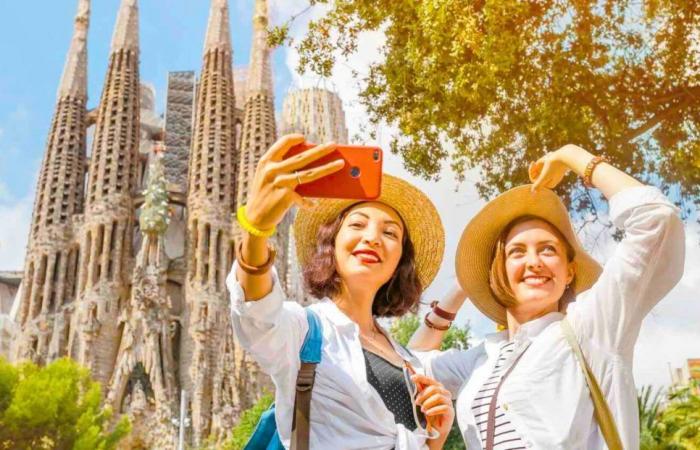Barcelona, one of the most popular tourist destinations in the world, is faced with a paradoxical situation. On the one hand, the city is delighted with the massive influx of visitors attracted by its exceptional cultural and architectural heritage. On the other, the phenomenon of “selfie-tourism” creates increasing tensions. The city therefore decided to intervene by creating a space specially dedicated to selfies near the Sagrada Familia. But does this answer, which aims to relieve tensions caused by tourist overcrowding, is not likely to come close to radicality?
The boom in selfie-tourism becomes an uncontrollable phenomenon
The Sagrada Familia, a masterful work of the architect Antoni Gaudí, is undoubtedly one of the most photographed monuments in the world. Each year, about 4.7 million visitors Broken to admire this impressive basilica, making it second most visited tourist site in Spain after the Alhambra. However, this incessant flow of tourists is accompanied by a major problem: the invasion of public space by people looking for the perfect selfie.
The streets around the Sagrada Familia have become Chaos placeswhere visitors block the sidewalks, rush on the roads and disrupt traffic to take photos. A trend popularized by social networks, notably Tiktok, even pushed tourists to film themselves on the mechanical stairs of the metro, more disturbing the fluidity of the daily life of Barcelona.
The zone dedicated to selfies, a solution seen as radical
Faced with this phenomenon, the municipality of Barcelona has announced the construction of a 600 square meter area dedicated exclusively to taking selfies. Located between the facade of the Nativity of the Sagrada Familia and Placed Gaudí, this area will serve as a real “anteroom” for tourists before entering the monument. The project, at a cost of 2.7 million eurosaims to unclog the streets and offer visitors a space in which they will be able to satisfy their desire for photography without disturbing residents or other tourists.
Planned to be completed in April 2026the project is part of a larger plan of 15.5 million euros to improve tourism management around the basilica and better supervise the flow of visitors in the city. This initiative echoes a substantive trend, where many cities seek to regulate tourism To preserve the authenticity of emblematic sites.
Does the “selfie-tourism” become a global scourge?
The phenomenon of selfie-tourism is not unique in Barcelona. All over the world, historical and natural places see their infrastructure saturated by visitors more concerned with their image than by preserving sites. For example, the city of Portofino in Italy has set up fines for those who take too long to install for selfies. In Austria, a city famous for inspired the film Frozen, installed a fence to prevent photos of tourists.
Experts are concerned about ecological and social consequences of this phenomenon. According to UNESCO, the popularity of selfies could lead to the degradation of tourist sites, because visitors, more interested in the instantaneity of photos, often neglect the rules for preserving places.
A necessary, but insufficient response, according to Barcelona
If the creation of this dedicated space seems to be a pragmatic solution to tourism congestion, certain experts and residents of the city wonder if this measure is sufficient. The Barcelona authorities only attack here part of the problem, that linked to selfies. But what about other forms of mass tourism, just as disturbing? Other tourist hot spots such as Güell Park or Barceloneta beach are also faced with similar challenges, where the size of public spaces and the rise of nuisances become Daily problems.
It appears that this initiative, although useful, can only beA dressing on a much wider wound. To be really effective, Barcelona will undoubtedly have to go further by rethinking its long -term tourist policies, seeking a balance between tourist attractiveness and quality of life of residents.
Can this solution be adapted in the short term?
The creation of this area dedicated to selfies near the Sagrada Familia is A daring choice from the Barcelona authorities. If it aims to restore a certain order in public space, it solves only part of the problem, that of harmful behaviors linked to selfie-tourism.
In the long term, a more global approach will be necessary to supervise tourism in a more harmonious way and preserve the heritage while meeting the expectations of visitors. Barcelona seems to be committed to this path, but the question remains: will this gesture be enough to contain the irruption of the selfie in the historic places?








